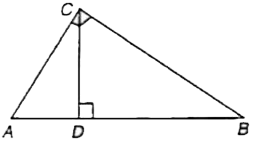In ΔABC,∠C=90∘ and CD is perpendicular to AB at D. If ADBD=√k, then ACBC=?
a)k
b)√k
c)1√k
d)4√k
The correct Answer is:D
To solve the problem, we will use the properties of similar triangles and the given ratio of segments.
1. Identify the Triangles: In triangle ΔABC, we know that ∠C=90∘. The point D is where the perpendicular CD meets AB. This creates two smaller triangles, ΔACD and ΔBCD.
2. Use the Given Ratio: We are given that ADBD=√k. Let's denote AD=x and BD=y. Thus, we can write:
xy=√k
3. Express AB: The total length of AB can be expressed as:
AB=AD+BD=x+y
4. Relate the Sides: From the properties of similar triangles ΔACD and ΔBCD, we can write:
AC2=AD⋅ABandBC2=BD⋅AB
5. Substitute for AB: Since AB=x+y, we can rewrite the equations:
AC2=AD⋅(AD+BD)=x(x+y)
BC2=BD⋅(AD+BD)=y(x+y)
6. Form the Ratio: Now, we can form the ratio AC2BC2:
AC2BC2=x(x+y)y(x+y)=xy
7. Substitute the Known Ratio: Since xy=√k, we have:
AC2BC2=√k
8. Take the Square Root: To find ACBC, we take the square root of both sides:
ACBC=√√k=k1/4
Final Answer:
ACBC=k1/4
xy=√k
AB=AD+BD=x+y
AC2=AD⋅ABandBC2=BD⋅AB
AC2=AD⋅(AD+BD)=x(x+y)
BC2=BD⋅(AD+BD)=y(x+y)
AC2BC2=x(x+y)y(x+y)=xy
AC2BC2=√k
ACBC=√√k=k1/4
ACBC=k1/4
Similar Questions
Knowledge Check
- Question 1 - Select One
In a right angled ΔABC,∠C=90∘andCD is the perpendicular on the hypotenuse AB,AB=c,BC=a,AC=bandCD=p, then :
 Apq=pbB1p2+1b2=1a2Cp2=b2+c2D1p2=1a2+1b2
Apq=pbB1p2+1b2=1a2Cp2=b2+c2D1p2=1a2+1b2 - Question 2 - Select One
In a right angled ΔABC,∠C=90∘andCD is the perpendicular on hypotenuse AB if BC = 15 cm and AC=20cm then CD is equal to :
 A18 cmB12 cmC17.5 cmDcan't be determined
A18 cmB12 cmC17.5 cmDcan't be determined - Question 3 - Select One
In ΔABC,∠BAC=90∘andAD is drawn perpendicular to BC . If BD -=7 cm and CD = 28 cm , what is the length (in cm ) of Ad ?
A3.5B7C10.5D14
In a triangle ABC, ∠B=90∘,AB=8cm,BC=6cm. BD is perpendicular to AC, then find the length of CD, AD and BD.
View SolutionIn a ΔABC,∠B=90∘,∠C=45∘ and D is mid point of AC. If AC = 4√2 unit then BD is
View SolutionIn ΔABC,∠BAC=90∘andAD is drawn perpendicular to BC . If BD -=7 cm and CD = 28 cm , what is the length (in cm ) of Ad ?
View SolutionIn ΔABC,∠C=90∘. D is the midpoint BC : and DE⊥AB at E. If AB =13 cm and BE =5 cm, then the area of the square drawn on BC is equal to :
View SolutionIn ΔABC,∠C=54∘, the perpendicular bisector of AB at D meets BC at E. If ∠EAC=42∘, then what is the value (in degrees) of ∠ABC?
View Solution

